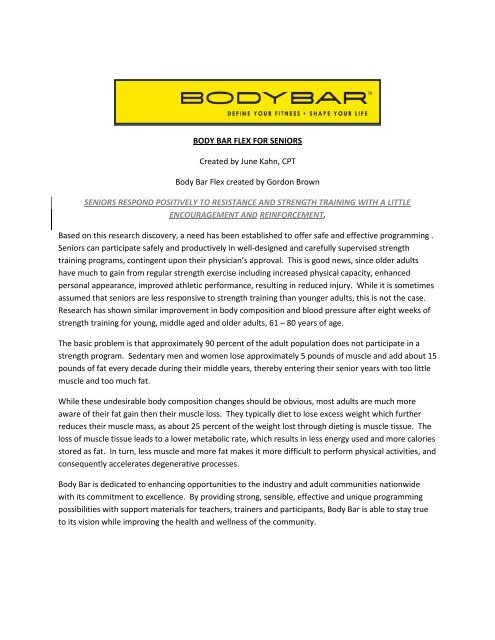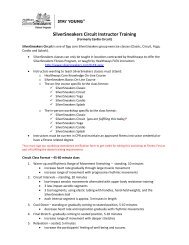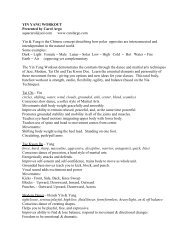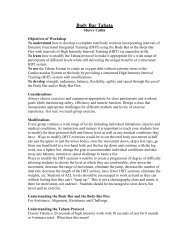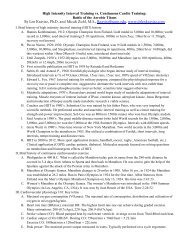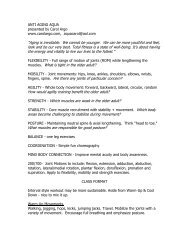body bar flex for seniors - FitnessFest
body bar flex for seniors - FitnessFest
body bar flex for seniors - FitnessFest
You also want an ePaper? Increase the reach of your titles
YUMPU automatically turns print PDFs into web optimized ePapers that Google loves.
BODY BAR FLEX FOR SENIORS<br />
Created by June Kahn, CPT<br />
Body Bar Flex created by Gordon Brown<br />
SENIORS RESPOND POSITIVELY TO RESISTANCE AND STRENGTH TRAINING WITH A LITTLE<br />
ENCOURAGEMENT AND REINFORCEMENT.<br />
Based on this research discovery, a need has been established to offer safe and effective programming .<br />
Seniors can participate safely and productively in well-designed and carefully supervised strength<br />
training programs, contingent upon their physician’s approval. This is good news, since older adults<br />
have much to gain from regular strength exercise including increased physical capacity, enhanced<br />
personal appearance, improved athletic per<strong>for</strong>mance, resulting in reduced injury. While it is sometimes<br />
assumed that <strong>seniors</strong> are less responsive to strength training than younger adults, this is not the case.<br />
Research has shown similar improvement in <strong>body</strong> composition and blood pressure after eight weeks of<br />
strength training <strong>for</strong> young, middle aged and older adults, 61 – 80 years of age.<br />
The basic problem is that approximately 90 percent of the adult population does not participate in a<br />
strength program. Sedentary men and women lose approximately 5 pounds of muscle and add about 15<br />
pounds of fat every decade during their middle years, thereby entering their senior years with too little<br />
muscle and too much fat.<br />
While these undesirable <strong>body</strong> composition changes should be obvious, most adults are much more<br />
aware of their fat gain then their muscle loss. They typically diet to lose excess weight which further<br />
reduces their muscle mass, as about 25 percent of the weight lost through dieting is muscle tissue. The<br />
loss of muscle tissue leads to a lower metabolic rate, which results in less energy used and more calories<br />
stored as fat. In turn, less muscle and more fat makes it more difficult to per<strong>for</strong>m physical activities, and<br />
consequently accelerates degenerative processes.<br />
Body Bar is dedicated to enhancing opportunities to the industry and adult communities nationwide<br />
with its commitment to excellence. By providing strong, sensible, effective and unique programming<br />
possibilities with support materials <strong>for</strong> teachers, trainers and participants, Body Bar is able to stay true<br />
to its vision while improving the health and wellness of the community.
PROGRAM OBJECTIVES<br />
1. To create a safe, sound and effective basic exercise program <strong>for</strong> Seniors focusing on movement<br />
patterns to enhance balance, strength and <strong>flex</strong>ibility<br />
2. To provide an updated fitness program based on current research findings to meet the needs of<br />
the mature population to improve function of daily living.<br />
3. To introduce the Body Bar Flex as a unique, lightweight, bendable tool that allows <strong>seniors</strong> to<br />
build strength without lifting weight.<br />
4. To provide a foundation <strong>for</strong> teachers to build upon and <strong>for</strong> use in their program and community<br />
offerings<br />
5. To create a base line workout that is designed <strong>for</strong> all fitness levels of <strong>seniors</strong>.<br />
PROGRAM DESCRIPTION<br />
Body Bar Flex Senior Fit Program is a fun, energizing program that helps older adults gain greater<br />
independence through physical activity. This program delivers safe, effective exercises through a<br />
workout designed to enhance functional strength, balance and <strong>flex</strong>ibility. Based on research, the gains<br />
in strength, balance and <strong>flex</strong>ibility transfers to improve function of daily living giving the active adult the<br />
ability to maintain their independence.<br />
Each exercise is designed to improve joint mobility and stability through integrated movement patterns<br />
while using the Body Bar Flex. There<strong>for</strong>e, more than one muscle is used at a time, allowing the <strong>body</strong> to<br />
train <strong>for</strong> improved function. Participants are recommended to bend the Body Bar Flex as much as is<br />
com<strong>for</strong>table. As strength and/or <strong>flex</strong>ibility is increased, the participant can adjust the position of their<br />
grip closer to the middle of the <strong>bar</strong> to increase the challenge.<br />
PROGRAM BENEFITS<br />
<br />
<br />
<br />
<br />
<br />
<br />
<br />
<br />
<br />
<br />
<br />
Increased muscular and functional strength<br />
Enhanced functional <strong>flex</strong>ibility leading to improved overall joint range of motion<br />
Improved balance of strength to <strong>flex</strong>ibility<br />
Strong Core<br />
Increased muscle tone of upper and lower <strong>body</strong><br />
Increased response and reaction time<br />
Improved balance<br />
Increased Spinal mobility and stability<br />
Improved quality of movement<br />
Improved posture and alignment<br />
Enhanced mental outlook
PROGRAM DESIGN<br />
Warm Up Stretches involving dynamic stretching <strong>for</strong> enhanced mobility<br />
Progressive Integrated Movement patterns <strong>for</strong> Total Body Conditioning<br />
Dynamic Cool Down and Stretch<br />
For older adults and <strong>seniors</strong> who want to stay healthy and independent, the National Institutes of Health<br />
(NIH) recommend four types of exercises:<br />
Strength exercises build older adult muscles and increase your metabolism, which helps to keep your<br />
weight and blood sugar in check.<br />
Balance exercises build leg muscles, and this helps to prevent falls. According to the NIH, U.S.<br />
hospitals have 300,000 admissions <strong>for</strong> broken hips each year, many of them <strong>seniors</strong>, and falling is<br />
often the cause of those fractures.<br />
If you are an older adult, balance exercises will help you avoid problems ar you get older.<br />
And if you are a senior, balance exercises can help you stay independent by helping you avoid the<br />
disabilities that could result from falling.<br />
Stretching exercises can give you more freedom of movement, which will allow you to be more<br />
active during your senior years. Stretching exercises alone will not improve your endurance or<br />
strength.<br />
Endurance exercises are any activity—walking, jogging, swimming, biking, even raking leaves—that<br />
increases your heart rate and breathing <strong>for</strong> an extended period of time. Build up your endurance<br />
gradually, starting with as little as 5 minutes of endurance activities at a time.<br />
FREQUENCY<br />
1 – 3 Sessions per week, minimally once per week. Program has built in rest periods as exercises<br />
transition from seated to standing. Students encouraged to take a rest between exercises if fatigue<br />
occurs in beginning phases. Release tension on the <strong>bar</strong> when necessary until endurance levels are<br />
progressively increased. Start with 3 – 5 repetitions, building up to 8 – 10 repetitions as strength<br />
increases
EXERCISES<br />
WARM UP<br />
LEGS<br />
1. Seated Roll Down Push with Arm Raises<br />
2. Standing Mermaid Stretch<br />
3. Wide Squat with Chest Press and Rotation – Targets Legs, Chest and Torso Rotators<br />
4. Hamstring Stretch with Knee Lift and Extension – Stretches Hamstrings, strengthens hips and<br />
front of legs<br />
5. Star- Strengthens Front, Side and Back of legs and hips. Challenges Balance<br />
6. Tight Rope- Enhances Gait and Challenges Balance<br />
BACK AND SHOULDERS/CHEST<br />
7. Seated or Standing Back Pull – Targets Upper back and arm muscles and Scapular Retraction<br />
8. Seated or Standing Back Row with Rotation – Targets Mid Back and arm muscles, Horizontal<br />
Adduction of Shoulder Girdle with Rotation<br />
9. Seated or Standing Single Shoulder Raise and Lat Pull with External Rotation – Targets<br />
Shoulders, Back and External Rotators, Biceps and Triceps<br />
10. Seated Shoulder Raise and Side Oblique Crunch – Targets Shoulders and Obliques<br />
11. Standing or Seated Chest Press with Spine Twist – Targets Chest and Shoulder muscles, Torso<br />
Rotators<br />
ARMS/BACK AND OBLIQUES<br />
12. Standing or Seated Bicep Curls – Targets Biceps and Core Muscles in Standing Postion<br />
13. Seated Tricep press – Targets Triceps<br />
14. Standing or Seated Pull Down – Targets Back and Arm Muscles<br />
15. Standing or Seated Oblique Crunch- Targets Oblique and Abdominal Muscles, In standing<br />
position, challenges balance<br />
ABDOMINALS<br />
16. Seated Abdominal Crunch – Targets Abdominal Muscles<br />
17. Supine Abdominal Curl – Bar behind head, knees bent – Targets Abdominal Muscles, Strengthen<br />
Neck Muscles<br />
BACK EXTENSION
18. Rolling Sphinx – Targets Abdominals and Shoulder Stabilizing Muscles<br />
COOL DOWN STRETCHES<br />
19. Supine Cat and Cow – Stretches lower back and abdominals, enhances torso stabilizers<br />
20. Supine Hamstring Stretch – Stretches Hamstrings and Hip Flexors<br />
Thanks <strong>for</strong> attending this workshop!<br />
Presented by:<br />
June E Kahn, CPT<br />
2009 IDEA World Fitness Instructor of the Year<br />
www.junekahn.com


